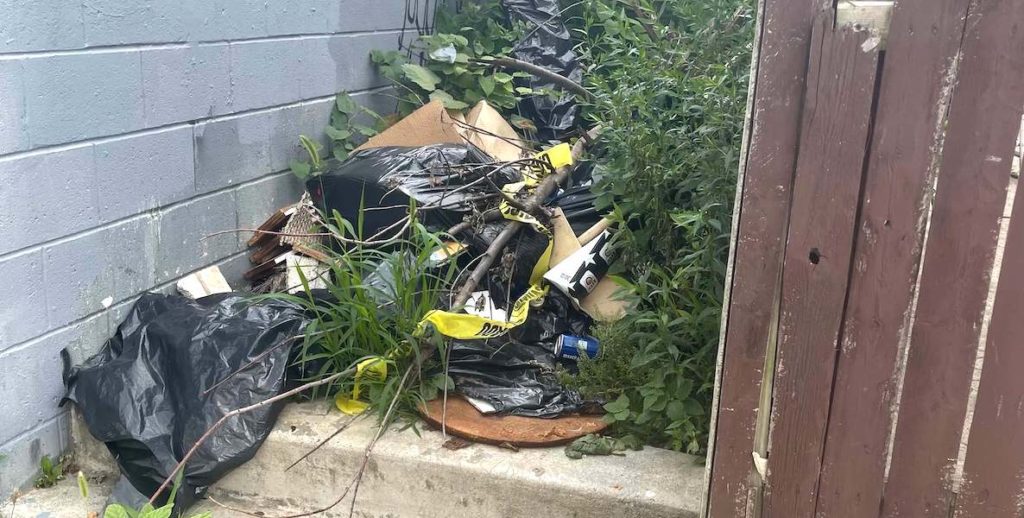Walking the streets of North Philadelphia, it’s all too common to run into—and I mean literally run into—oversized trash. From dirty mattresses to old sofas, broken tables and more, illegal dumping is everywhere once you open your eyes to it.
In the span of just three days, this mystery shopper noticed:
- Day 1: Back alleyway: battered lawn chairs, hundreds of crushed beer cans, smashed speaker; obviously the detritus of some type of “totally tubular” frat party. Gross, dude.
- Day 2: The sidewalk: assorted men’s clothing, a broken gaming system, old toothbrush, toothpaste, and hair care products. Remnants of a bitter breakup?
- Day 3: A vacant lot: broken concrete, mounds of black trash bags, dozens of plastic bags, scattered pieces of broken furniture. Who knows?
- Day 4: I said “enough” and set out to find a way to rid my beautiful city of the nasty garbage.
Illegal dumping might be the reason Philadelphia is consistently ranked one of the dirtiest cities in America. We all see it, but what can residents do to clean up our sidewalks? How hard is it to get illegal dumping removed? It might be simpler than you think…
Steps we took to report illegal dumping in Philadelphia
- I spied a big pile of trash dumped near my street, and set out to determine: Is it legal or illegal dumping? I Googled “illegal trash dumping in Philly.”
- The first search results was “Report Illegal Dumping” on phila.gov. It said: “It is illegal to dump garbage in public spaces or on private property.” Said trash pile is smack dab in the middle of the sidewalk, so that would be a yes.
- Under the tab that says “How,” it says to “call 911 if I see it in action,” or I can fill out the form below.
- I click on the form and fill out the location, a description of the individual(s), the make, model, color, and license plate of any vehicles, and the material being dumped. (I only have the location and the material that was dumped, so I am not sure how accurate the report will be.)
- Next, I can either login or sign up on the Philly311 page to fill out another form.
- The first thing I must do on this form is fill out the address where the dumping is, so I put the address of the house that the illegal dumping is closest to.
- Next, I answer a series of questions, including:
– “Is the trash on a vacant lot?”
– “Is there commercial hazardous waste?”
– “Does it include hazardous household waste?”
– “Is the trash in the bike lane, street or the sidewalk?”
– “Is there active construction on the site?”
– “What are the conditions of the material?”
– “Large Crew & Heavy Machinery To Clean Up?”
– “What is the type of material?”
– “Description of Vehicle/Person Involved if known”
– “Your Name & Contact Number”
– “Description: Anything else we should know about the issue” (I can choose between making the request public or private) - Finally, I can add a picture, then click “Submit.”
- I can track the progress of my report by clicking “ Track a Service Request with 311” or by downloading and logging into the Philly 311 app.
- Now I wait… and wait… and wait…
Time spent: 10 minutes to navigate the website and fill out two forms; 4 weeks waiting for the request to be “completed”.
Result: Once my request status was changed to “completed,” I felt reassured this drawn-out process was all worth it…until I walked past the illegal dumping site and noticed a majority of the trash still in its original place. Um…
Takeaways: While Philly 311 has the potential to become an easy and reliable solution to get rid of illegal dumping, in this case at least it did not work as promised. Weeks of walking by the site with no action, followed by an incomplete clean-up? This is not good city service by any means; it is more or less a complete failure.
Lightning bolt rating: 0
RELATED
Mystery Shopper: How hard is it to get rid of illegal dumpsters?

